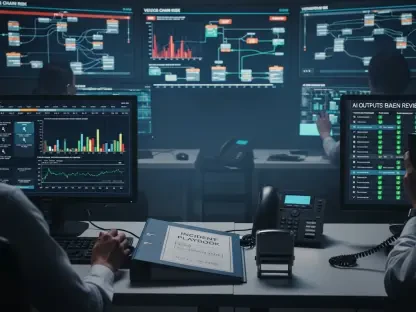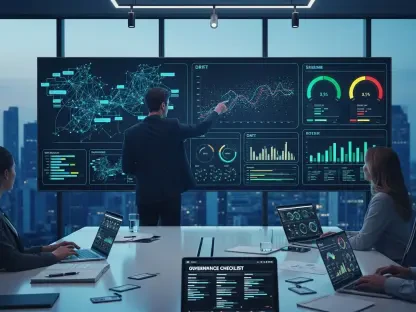The trucking insurance industry stands at a pivotal moment, wrestling with an unprecedented surge in costs while navigating the transformative impact of artificial intelligence (AI) and other cutting-edge technologies. As a cornerstone of global supply chains, this sector is under immense strain from financial pressures like skyrocketing premiums and massive jury awards, alongside external risks such as geopolitical tensions and regulatory shifts. At the same time, technological advancements promise to revolutionize risk management, offering tools to enhance safety and efficiency, yet they also introduce complex challenges like cyber vulnerabilities and liability disputes. This dynamic landscape demands a delicate balance between embracing innovation and mitigating emerging threats, as carriers and insurers alike strive to adapt to a rapidly changing environment. The stakes are high, with the sustainability of trucking operations hanging in the balance, making it crucial to understand the forces reshaping insurance in this critical industry.
Financial Pressures Reshaping the Industry
The most immediate concern for trucking insurance today is the steep climb in premiums, with commercial auto insurance rates increasing by 15% year-over-year according to recent market analyses. This dramatic rise is largely fueled by the growing prevalence of “nuclear verdicts,” where juries award damages exceeding $10 million, driven by aggressive litigation tactics and social inflation. Smaller fleets, often operating on tight margins, find themselves disproportionately affected, as the escalating costs threaten to push them out of the market entirely. The financial burden is compounded by the ripple effects of these massive payouts, which not only strain individual carriers but also contribute to a broader hardening of the insurance market, where coverage becomes more expensive and harder to obtain for all players in the sector.
Beyond the raw numbers, the impact of these rising costs reveals a deeper fragility within the industry. Carriers are forced to make tough decisions, such as cutting back on fleet size or passing increased expenses on to customers, which can erode competitiveness in an already cutthroat market. Social inflation, where societal attitudes drive up claim values beyond economic inflation, adds another layer of complexity, as public perception often sways juries toward larger awards regardless of case merits. This trend places immense pressure on insurers to reassess risk models and premium structures, while smaller operators grapple with the looming risk of insolvency if they cannot absorb or offset these mounting financial hits. The situation underscores a critical need for systemic changes to address litigation excesses and stabilize costs.
Technology as Both Solution and Risk
Artificial intelligence and related technologies like telematics are reshaping how risk is managed in trucking, offering powerful tools to enhance safety and efficiency. Predictive analytics and dash cams, for instance, enable real-time monitoring of driver behavior, with studies suggesting a potential reduction in accident rates by as much as 20%. Usage-based insurance (UBI) models, which adjust premiums based on telematics data, provide an opportunity for safe operators to lower costs by 10-15%, creating a direct incentive for better practices. These advancements signal a shift toward more personalized and data-driven insurance products, which could fundamentally alter the relationship between carriers and insurers by aligning financial outcomes with operational performance.
However, the integration of AI introduces a host of new risks that cannot be overlooked. Cyber vulnerabilities stand out as a major concern, with connected systems becoming prime targets for hackers who could disrupt operations or steal sensitive data. Privacy issues also loom large, as the collection of detailed driver and vehicle information raises questions about consent and data security. Additionally, when AI systems fail or contribute to accidents, liability disputes become far more complex, often leaving courts to untangle whether responsibility lies with the technology, the operator, or the manufacturer. These challenges highlight the dual nature of technological progress in this space, where the promise of reduced accidents and costs must be weighed against the potential for new, uncharted exposures that the industry is still learning to navigate.
Evolving Liability in the Age of Autonomy
The emergence of autonomous trucks is upending traditional liability models, creating a seismic shift in how responsibility is assigned in the trucking sector. As these vehicles reduce reliance on human drivers, the focus of claims may move from operator error to manufacturer accountability, increasing product liability exposures for companies behind the technology. This transition could potentially lower claims tied to human mistakes, but it also raises intricate questions about who bears the cost when autonomous systems malfunction or fail to prevent accidents. Insurers are now tasked with developing policies that account for these evolving dynamics, a process complicated by legal frameworks that have yet to fully adapt to this technological frontier.
Compounding the issue is the uncertainty surrounding the pace and scale of autonomous truck adoption, which varies widely across regions and fleet sizes. Larger carriers with resources to invest in cutting-edge tech may transition faster, leaving smaller operators reliant on traditional models and potentially facing higher relative premiums. The lack of standardized guidelines for liability in autonomous scenarios further muddies the waters, as courts and regulators grapple with precedent-setting cases that could redefine insurance obligations. For now, the industry must prepare for a hybrid landscape where human-driven and autonomous trucks coexist, each carrying distinct risk profiles that demand tailored coverage solutions. This evolving reality underscores the urgency of updating legal and insurance frameworks to keep pace with innovation.
External Forces Driving Up Risks
Beyond internal industry challenges, a range of external pressures are amplifying risks and costs for trucking insurance. Geopolitical tensions, such as trade disputes and energy price volatility, create operational headaches, particularly for cross-border haulers who face fluctuating tariffs and compliance costs. Economic factors like inflation exacerbate the situation by driving up repair and labor expenses, while sustainability regulations push fleets to invest in greener technologies that often come with higher upfront costs and untested risk profiles. These combined forces create a volatile environment where carriers must navigate not only their core business but also a web of global and regulatory uncertainties that directly impact insurance needs and expenses.
Another critical external challenge is the persistent driver shortage, which contributes to capacity imbalances and overworked staff, ultimately leading to higher accident rates. Social media discussions among industry professionals reveal growing frustration over related issues, such as undocumented drivers inadvertently invalidating policies and creating administrative nightmares. Economic stagnation in freight demand, despite rising numbers of Commercial Driver’s License holders, adds further strain, as carriers struggle to match resources with market needs. These external stressors highlight how interconnected the trucking sector is with broader economic and political trends, making it clear that insurance solutions must account for risks far beyond the highway to remain effective and relevant.
Strategies for Building Resilience
In the face of these multifaceted challenges, carriers and insurers are taking proactive steps to build resilience and adapt to the shifting landscape. Fleets are increasingly investing in driver training programs and advanced safety technologies, such as collision avoidance systems, to reduce accident frequency and demonstrate lower risk to insurers, potentially curbing premium hikes. These efforts reflect a growing recognition that operational improvements can directly influence financial outcomes in a market where every claim carries outsized consequences. By prioritizing safety and efficiency, carriers aim to not only protect their bottom line but also position themselves as attractive partners for insurers seeking to minimize exposure.
Insurers, meanwhile, are leveraging big data to develop personalized policies that better reflect individual fleet risks, moving away from one-size-fits-all approaches. Innovative products like parametric insurance, which trigger payouts based on predefined events rather than traditional claims processes, are also gaining traction as a way to streamline coverage and reduce disputes. These adaptations signal a broader shift toward flexibility and precision in underwriting, though they require significant investment in technology and data infrastructure. Both carriers and insurers understand that staying ahead of rising costs and risks demands a willingness to rethink longstanding practices, even as they navigate the uncertainties of implementation and market acceptance.
Forging a Path Through Collaboration
Addressing the persistent challenges in trucking insurance necessitates a unified approach, as individual efforts alone cannot tackle systemic issues like cyber threats and rampant litigation. Industry consensus points to the critical need for collaboration among carriers, insurers, and regulators to develop comprehensive solutions, such as tort reform to limit nuclear verdicts that inflate premiums. Standardized guidelines for AI integration are equally vital, ensuring that technological advancements do not outpace the frameworks needed to manage their risks. Without such cooperative action, the sector risks being overwhelmed by unresolved tensions that could undermine even the most promising innovations.
Looking ahead, the importance of advocacy and dialogue cannot be overstated, as stakeholders must work together to shape policies that balance innovation with stability. Recent discussions within the industry suggest that successful legal defenses against excessive verdicts have provided a blueprint for broader reform, while pilot programs for AI-driven claims processing offer glimpses of streamlined operations by as early as the next few years. These examples underscore the potential for progress when shared goals drive collective action. As the trucking insurance landscape continues to evolve, the commitment to partnership and reform will be the linchpin in ensuring that the sector remains a reliable backbone of global commerce, capable of withstanding both current pressures and future uncertainties.









